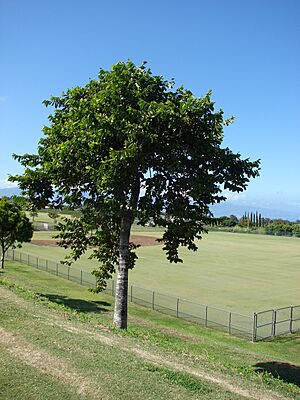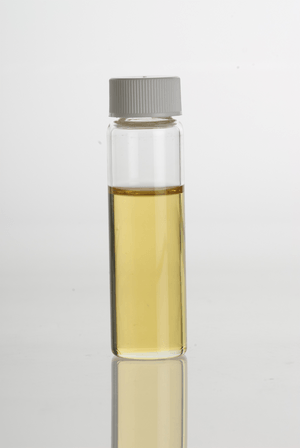Ylang-ylang facts for kids
Quick facts for kids Ylang-ylang tree |
|
|---|---|
 |
|
| Flowers of Cananga odorata | |
| Scientific classification | |
| Genus: |
Cananga
|
| Species: |
odorata
|

The Ylang-ylang tree (scientific name: Cananga odorata) is a beautiful tropical tree. It is also known as the cananga tree. This tree grows naturally in places like India, Malaysia, the Philippines, Indonesia, and Queensland, Australia.
People love the ylang-ylang tree for its amazing flowers. These flowers are used to make a special perfume called ylang-ylang EE-lahng-EE-lahng. This perfume is an essential oil and is often used in aromatherapy. You might also hear this tree called the fragrant cananga or perfume tree.
Some traditional names for the ylang-ylang tree in Polynesian islands include Mata‘oi (Cook Islands) and Moso‘oi (Samoa).
There are also climbing plants related to the ylang-ylang tree. These include the ylang-ylang vine (Artabotrys odoratissimus) and climbing ylang-ylang (Artabotrys hexapetalus). They are evergreen climbing plants. Artabotrys odoratissimus also has a lovely scent.
Contents
What's in a Name?
The name ylang-ylang comes from the Tagalog word ilang-ilang. This word means "wilderness" or "wild". It describes where the tree naturally grows. Some people mistakenly think it means "flower of flowers."
What the Ylang-ylang Tree Looks Like
The Cananga odorata is a tree that grows very fast. It belongs to the custard apple family. It can grow more than 5 m (16 ft) each year. In a good climate, it can reach about 12 m (39 ft) tall.
Its leaves are smooth and shiny. They are oval-shaped with wavy edges and are about 13–21 cm (5–8.5 in) long. The flowers hang down and have six narrow petals. They are usually greenish-yellow, but sometimes pink. They look a bit like a sea star. These flowers produce a very strong and pleasant smell.
There is also a smaller version called Cananga odorata var. fruticosa. This dwarf ylang-ylang grows as a small tree or a bushy plant. It also has very fragrant flowers.
Where Ylang-ylang Trees Grow
This plant is native to many tropical parts of Asia. You can find it from India all the way to Papua New Guinea and Queensland, Australia. It is also commonly grown in places like Madagascar, Polynesia, and the Comoros islands.
Ylang-ylang trees like to grow in sunny or partly sunny spots. They prefer the slightly acidic soil found in their native rainforest homes. Sometimes, people grow ylang-ylang in cooler places, but only in special greenhouses.
Ylang-ylang and Animals
The black fruits of the ylang-ylang tree are an important food for many birds. These birds include different types of imperial-pigeons and fruit-doves. The Sulawesi red-knobbed hornbill helps spread the seeds of the ylang-ylang tree.
How Ylang-ylang is Used
The essential oil from ylang-ylang flowers is very popular.
- In Perfumes: It is widely used in making perfumes, especially those with oriental or floral scents. A famous perfume, Chanel No. 5, uses ylang-ylang oil. It mixes well with many other flower, fruit, and wood smells.
- In Aromatherapy: People use the essential oil in aromatherapy. Some believe it can help with high blood pressure. It is also thought to help with skin problems by balancing oil production.
- Traditional Uses:
- In Indonesia, ylang-ylang flowers are often spread on the bed for newlywed couples.
- In the Philippines, the flowers are strung into necklaces, called lei, along with sampaguita flowers. Women wear these, and they are also used to decorate religious statues.
- Economy: Ylang-ylang essential oil is a big export for the Comoros islands. In 1998, it made up 29% of their total exports. Madagascar also grows ylang-ylang and exports its essential oils around the world.
- Other Products: Ylang-ylang essential oil is one of the main ingredients in macassar oil.
Ylang-ylang Essential Oil
What the Oil Smells Like
The smell of ylang-ylang oil is rich and deep. It can have hints of rubber and custard, mixed with bright notes of jasmine and neroli. People often describe its scent as heavy, sweet, and slightly fruity and floral.
The essential oil is made by a process called steam distillation. This means steam is passed through the flowers to collect the oil. The oil is then separated into different grades (like extra, 1, 2, or 3). These grades depend on when the oil is collected during the distillation process.
The main chemicals that give ylang-ylang oil its special smell are benzyl acetate, linalool, p-cresyl methyl ether, and methyl benzoate.
What's in the Oil
Here are some of the chemicals found in ylang-ylang essential oil:
- Linalool
- Germacrene
- Geranyl acetate
- Caryophyllene
- p-Cresyl methyl ether
- Methyl benzoate
- Sesquiterpenes
See also
In Spanish: Cananga odorata para niños



